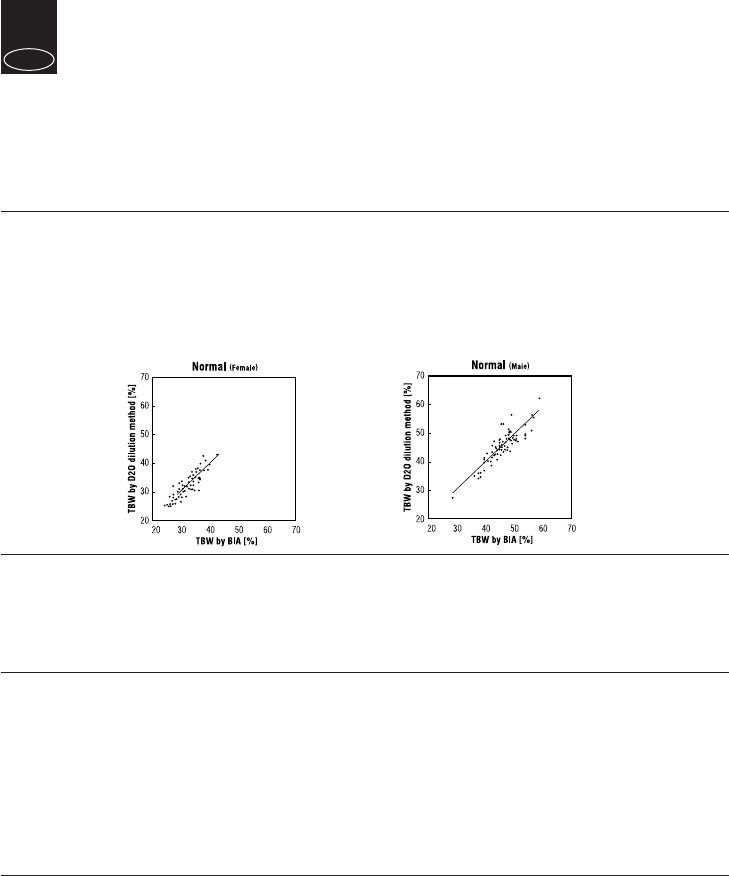
E
PRESTACIONES Y FUNCIONES
PREPARACIONES ANTES DEL USO
Instalación de las pilas
Abrir la tapa de las pilas situada en la parte posterior de la báscula. Insertar
como se indica las baterías AA suministradas.
Nota: Asegúrese de situar correctamente la polaridad de las pilas. Si coloca las pilas de
manera incorrecta, el líquido puede derramarse y dañar el suelo. Si no tiene
intención de utilizar esta unidad durante un período de tiempo prolongado, se
recomienda sacar las pilas antes de guardarla.
Por favor, tenga en cuenta que desde que las pilas fueron colocadas en
fábrica puede haber disminuido su nivel de energía.
Colocación del monitor
Coloque la báscula en una superficie dura y lisa con una vibración mínima
para asegurar una medición segura y precisa.
Nota: Para evitar posibles lesiones, no pise el borde de la plataforma.
Recomendaciones de manejo
Este monitor es un instrumento de precisión que utiliza tecnología de
vanguardia. Para mantener la unidad en condición óptima, siga estas
instrucciones cuidadosamente:
• No intente desmontar la báscula.
• Guarde el aparato horizontalmente y colóquelo de manera que las teclas
no resulten presionadas accidentalmente.
• Evite que la unidad reciba golpes o vibraciones excesivas.
• Sitúe la unidad fuera del alcance de la luz directa del sol, calefacciones
y radiadores, humedad elevada o cambios extremos de temperatura.
•
No lo sumerja nunca en agua. Utilice alcohol para limpiar los electrodos y limpiacristales
(aplicado mediante un trapo) para mantenerlos brillantes; evite utilizar jabones.
• Evite la humedad al subirse a la plataforma.
• Evite que caiga cualquier objeto sobre el aparato.
Abrir como se muestra.
Sentido de las pilas.
Báscula
1. Pantalla de visualización
2. Botón de Configurar
3. Botones de flecha (Seleccionar)
4. Electrodos para la planta del pie
5. Electrodos para el talón
6. Teclas personales
Accesorios
7. Pilas tamaño AA (4)
7.
1.
2.
3.
4.
5.
6.
44
What is Total Body Water Percentage?
Total Body Water Percentage is the total amount of fluid in a person’s body expressed as a percentage of their total weight.
Approximately 50 –65% of the weight of a healthy person is water. Water plays a vital role in many of the body’s processes
and is found in every cell, tissue and organ. Maintaining a healthy total body water percentage will ensure the body
functions efficiently and will reduce the risk of developing associated health problems.
3
GB
How To Measure Total Body Water?
Deuterium Dilution Method is currently used as a typical method to measure a total body water percentage. This
instrument estimates the total body percentage by the analysis (Multiple Regression Analysis) based on the parameter
found by the BIA method.
A mutuality over 0.8 is obtained between this instrument and the “deuterium dilution method”.
Note: Deuterium Dilution Method is in terms of total body water based on the analysis of the dilution of orally ingested deuterium oxide in urine.
Healthy Total Body Water Percentage (%TBW)
The average total body water percentage ranges for a healthy adult are:
Female: 50 to 55%
Male : 60 to 65%
Note: The total body water percentage of a person with a high percentage of body fat may fall below the average healthy ranges.
Daily Rhythm of Total Body Water
Try to measure total body water percentage at the same time of day and under the same conditions. This increases the
accuracy of the readings. The best time is in the early evening, before the evening meal, when hydration levels are more
stable. Total body water percentage tends to be underestimated to a degree if measured immediately after getting out of
bed, not only because of dehydration but also because the fluid in the body will be stored centrally in the body’s trunk.
As the day progresses this fluid becomes more evenly distributed due to the effect of gravity.
On the contrary, it may be overestimated after exercise or taking a bath because of the movement of body water or a rise in
the body temperature despite actual dehydration.
Important Notes
• Take your measurements at the same time of day and under the same conditions.
• Measured results depend on the movement of water in the body and/or changes in body temperature. Factors
affecting total body water levels include sleep, physical activity, eating and drinking, illness and medications, bathing
patterns and urination.
• Take fluid immediately if you have any symptoms of dehydration, particularly after physical activity or bathing.
Symptoms include a dry mouth, headache, nausea, dizziness, skin dryness, a rise in temperature, loss of
concentration, etc. If symptoms persist, consult your doctor immediately.
• Elderly people are at increased risk of dehydration as they have less sensitivity to thirst and other rational symptoms.
• This instrument cannot be used to specifically determine an individual’s recommended total body water percentage.
Look for the long-term changes in total body water percentage and try to maintain a consistent, healthy total body
water percentage.











